Sports Stars (Page 2)
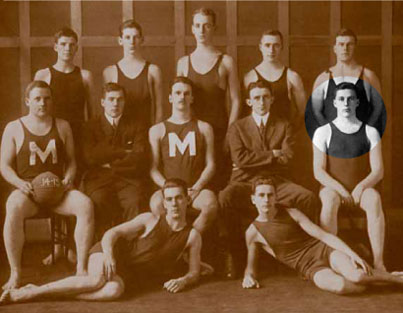
George Hodgson won two Olympic gold medals and set world records in swimming.
Making the Grade
Who decides which McGill athletes get into the Hall? The Sports Hall of Fame Selection Committee was first chaired by former principal David Johnston, LLD'00, followed by Hugh Hallward, BA'51, DLitt'92, who recently passed the torch to John Cleghorn, BCom'62, LLD'04. The chair presides over a nomination process which results in six or seven candidates being inducted yearly. Three types of nominees are considered: individuals, teams and "builders" who have made lasting contributions to McGill athletics. Candidates become eligible ten years after they have competed for a varsity team. Those who were outstanding but never competed for McGill - like former Montreal Canadiens goaltender and McGill Law grad Ken Dryden, LLB'73 - aren't eligible for the Hall.
Over 100 nominations at a time can be sitting before the Committee, and it falls to Earl Zukerman, BA'80, the Athletics Department's Communications Officer, to research those nominations. They come from quarters such as the Alumni Association, alumni groups and class representatives, as well as individuals, but they're often just names on scraps of paper. Drawing on sources such as old yearbooks, past issues of campus newspapers and magazines such as the McGill News, Zukerman spends much of his spring and summer fleshing out biographies. He describes digging into University history as a "fun project" - and "something we don't do enough of at McGill." He adds with a laugh, "If I billed them for all the extra hours I put in, I'd be a millionaire!"
The number of nominees is whittled down to ten every year and then sent to the Selection Committee, whose members debate the choices, then vote by secret ballot. According to Hallward, the discussion is lively but civil. "We've had a couple of hung juries, and that doesn't exactly please the Chairman. But we always end up with six or seven names that we're happy with."
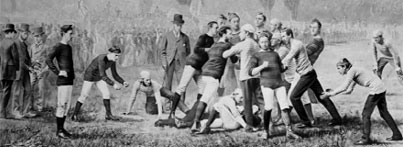
A William Notman composite photograph of the first intercollegiate football game ever played, between Harvard and McGill in 1874.
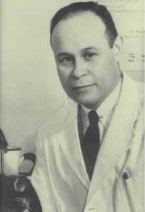
Dr. Charles Drew was a track star who led McGill to five intercollegiate titles and later invented the process of storing blood plasma for the modern blood bank.
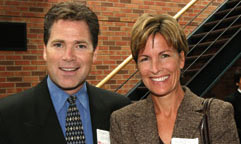
All-Canadian hockey star Mark Reade with his wife Karen at the Sports Hall of Fame Luncheon.
The Latest Round
Back at the Hall of Fame luncheon, it's clear that the 2004 inductees distinguished themselves both on and off the field. The late Sidney Pierce, BA'22, BCL'25, LLD'56, who competed at the 1924 Olympics, was a former Canadian ambassador to numerous countries. Harry Pangman, BEng'30, the coach of the 1932-33 ski team entering the Hall this year, has a peak named after him in Quebec's Laurentian Mountains. Former All-Canadian Mark Reade, BA'86, BCom'89, is a past winner of the Guy Lafleur Trophy, given to the hockey player who best combines academics with on-ice performance. When he stepped up to the podium to receive his plaque, he said, "What has struck me about the other inductees is that what they're here for is only a small portion of what they've done. And that I'm going to have to do a lot in my life to live up to it."
At 41, Reade is one of the youngest ever inducted. Although it may be dropped in years to come, there's been an informal agreement to each year elect half the athletes from before 1945, and half from after. As a result, there was a palpable air of nostalgia at the lunch. At the sportswriters' table, conversation drifted naturally to how professional athletes once behaved versus how they behave today, and guests were surrounded by posters of inductees photographed in black and white - all in uniforms today's students wouldn't be caught dead in.
One of the guests at the lunch was Mary Ball, who, with her sister, Martha MacKay, accepted the plaque for the 1932-33 Redbirds ski team on behalf of their late father, Bill Ball. Even a brief conversation with them about their dad's skiing exploits catapults you into a different era. The author of I Skied the '30s, Ball competed in the days when conditions were primitive and sport was quintessentially amateur. As Mary Ball recalled, her father and his teammates dressed in "big, baggy bloomers," and each had only one pair of skis, which were wooden, heavy, and used for all events. And since lifts were almost non-existent - and taking them "considered soft" - a large part of their training was dragging their skis up the hill. After which they would ski down again.
Another guest was Doug Heron, BSc'49. Unlike Ball and company - who played on what was then called a "club team" - this '04 inductee played the two highest profile sports, and in an atmosphere that would induce giddiness in today's varsity athletes. In the late '40s, Heron was a star fullback and kicker with the football team, and a star defenceman in hockey. In pre-television days, when professional sports had yet to come into their own, he performed to huge crowds and intense local interest. As he recalled recently, "The railways going down to out-of-town games were packed, the stadiums were full, and the parties at Toronto's Royal York Hotel afterwards were legendary."
Such keen fan support was due in part to the fact that professional salaries were low. So talented athletes like Heron - who was once offered $125 a week to play for the Toronto Argonauts - were a lot less likely to cut short their education. But there also seems to have been a totally different atmosphere surrounding university sports. Take the case of Dr. Leo Konyk, BSc(PE)'58, DDS'62, who was voted in posthumously this year for his play on '50s-era hockey and football teams. At the end of his career, the University held a "Leo Konyk Night." It's hard to imagine something like that being staged today - let alone it being standing room only.
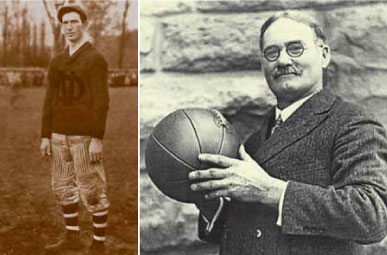
Left: Frank "Shag" Shaughnessy was a legendary McGill coach who
revolutionized the game of football and is pictured here during his short
baseball career.
Right: James Naismith is well known as the inventor of basketball and was a
director of physical training at McGill early in his career.
The Future of Athletics
Tom Thompson, BSc(PE)'58, MEd'78, who has long served on the Hall of Fame Committee and is an authority on McGill sports history, traces the decline of interest in varsity games to both the explosion of entertainment alternatives and the rise of personal fitness. Says Thompson, "In my day, you could hardly kidnap someone and force them into fitness. Their idea of exercise was to watch 'Rocket' Richard on television." But to those familiar with McGill's athletic golden days in the '30s, '40s and '50s, the tantalizing question remains: is it possible to recapture the fervour that once reigned?
Dubeau has certainly considered the question. And although he's not exactly optimistic, he has seen some encouraging signs. The resurgence of the popularity of football at Quebec's francophone universities is one of them. So is the fact that Principal Heather Munroe-Blum has shown interest in the plan to introduce scholarships for McGill athletes who meet the University's academic standards. Still, when he reflects on the atmosphere at the lunch, and the average age of those responsible for it, he sees a clear mandate: "Our challenge right now is to try and keep that feeling alive. So the people who are currently at McGill will continue to provide that support in the future."
There are some links that seem to be timeless, however, like the one that led to the meeting between Anne Turnbull and that unknown member of the Martlets. In fact, at the Hall of Fame Luncheon, the same note was sounded again and again. Doug Heron spoke of the "golfing and tennis buddies" he had known ever since his student days. Sheila Konyk spoke of the McGill friends who had come to her husband Leo's bedside before he died. And Mark Reade thanked the teammates who had made him "better on the ice, and better off the ice."
When they were done, it was hard not to remark on the irony that, for the most part, the Hall of Fame members should be pictured alone on their plaques. As if implying that without the encouragement and camaraderie of their teammates and fellow athletes, they could have triumphed, or would have been inspired to try.
For more on the Hall of Fame and its inductees, see www.athletics.mcgill.ca/main_halloffame.ch2.
Gavin Drummond is a Montreal freelance writer.


